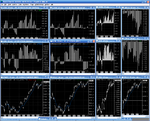Interesting article !
The Times
August 15, 2006
The US may be heading for a crash — but it's not the end of the world
American View by Gerard Baker
AS ELUSIVE objectives go, the economic soft landing used to be up there with lasting peace in the Middle East, the end to poverty in Africa and the cure for cancer. The idea that economies that flew too high, too fast could be brought down to earth with minimal discomfort was an attractive one. In recent years soft landings have become the norm rather than the exception. Britain has engineered a couple in the past decade when over-inflated house prices threatened to get out of control. Australia has done the same. The US authorities, impressively, brought the surging and bubble-propelled economy down to earth with only a very small recessionary bump in 2001. Now we are about to discover, with great consequence for the world, whether this run of successful soft landings can continue, or whether the US, the screaming engine of global growth for the past 5 years, is heading for a crash.
The Federal Reserve’s decision last week to leave interest rates unchanged underscores the degree of uncertainty in the US economic establishment about the near future. There are, broadly, three views among economists and, it seems, among Fed officials about what happens next.
The first, an optimistic assessment in keeping with recent economic history, favours the soft landing. The Fed has raised rates by just enough, according to this view, to restrain growth so as to squash inflation back into its box. The Fed funds rate now stands at 5.25 per cent; with inflation in the 2.5 per cent to 3 per cent range, that represents a real rate of about 2.5 per cent, a reasonable amount of restraint. Long-term Treasury yields have zigzagged higher in response. The Fed’s regional presidents forecast that the economy will grow at a rate of about 2.5 per cent for the rest of this year and most of 2007. That is a bit below America’s trend rate of growth of 3 per cent to 3.5 per cent these days, and so will result in a short phase of economic retrenchment,slightly higher unemployment and the like. But it should be relatively painless. Most important, opening up that little piece of slack in the economy will bring inflation back down to a rate that is more consistent with long-term, steady and prosperityenhancing expansion. On this view, the Fed probably won’t have to do anything more on interest rates for the foreseeable future — just watch in satisfaction as the economy slows to its desired pace.
The second view is pessimistic and fearful. It believes that the Fed has already gone too far. The housing market, the driver of so much demand for the global economy, is off sharply. Many Americans are desperately refinancing short-term adjustable rate mortgages they took out three years ago when rates were at historic lows. They are finding themselves with thousands of dollars less a year in disposable income than they had last year. Debt levels are sky high and the savings rate is negative. As consumers rebuild their tattered balance sheets, they will cut spending sharply, with catastrophic consequences. High oil prices are making matters even worse. On this assessment, the next move in rates will be down, if the Fed is to avert a really unpleasant shock to the economy. Some economists think the fed funds will be below 4.5 per cent by the middle of next year as Ben Bernanke, the beleaguered Fed Chairman, scrambles to avert a full-blown recession.
The third view might be called fatalistic realism. It accepts the second proposition that, on current policies, a recession is coming, but insists that it is absolutely necessary and its says that the Fed, far from pressing on the economic accelerator, should keep its foot on the brake. Inflation is already out of the box, in the view of a growing number of economists, shared in some parts of the Fed. The central bank’s favoured measure of inflation is the GDP deflator for personal consumption expenditures. If that sounds a bit technical, focus simply on the number. After stripping out the volatile food and energy components, it was running at 2.9 per cent in the second quarter of 2006, approximately unchanged from the 3 per cent rate of the first quarter. This is way too high for the proper comfort of even the most tolerant central banker and the indications are that it will go higher, even as the economy slows. As a return to an inflationary mindset is probably the single most alarming thing that worries policymakers, the Fed should, on this view, keep pushing interest rates higher. A recession may well simply be unavoidable.
In the 1990s, Norman Lamont, Britain’s most underrated Chancellor, was flayed on the altar of public opinion for saying that rising unemployment was a price “well worth paying” to squeeze inflation out of the system. It was anathema, of course, but economically gold-plated and the difficult decisions made at that time helped Britain eventually to enjoy its longest period of sustained growth in the past couple of centuries.
For the Fed, and the world, a recession may be the price that now needs to be paid to avert a longer-term catastrophe.

